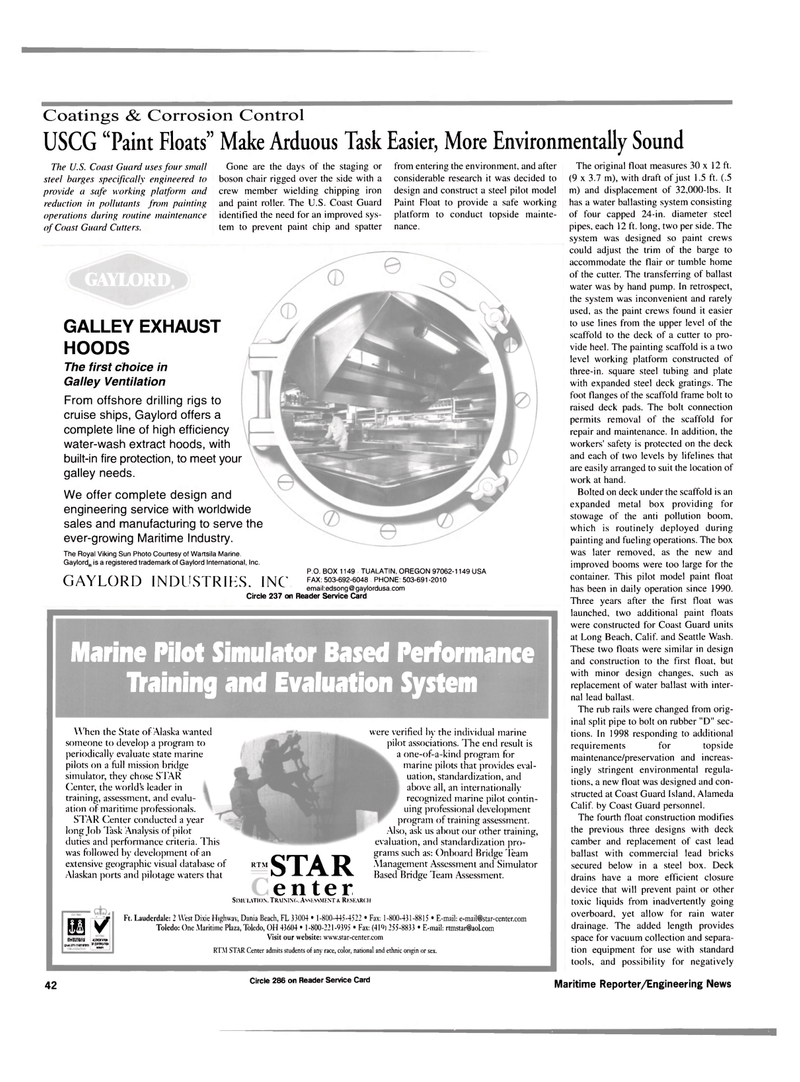
Page 42: of Maritime Reporter Magazine (August 2000)
Read this page in Pdf, Flash or Html5 edition of August 2000 Maritime Reporter Magazine
Coatings & Corrosion Control
USCG "Paint Floats" Make Arduous Task Easier, More Environmentally Sound
The U.S. Coast Guard uses four small steel barges specifically engineered to provide a safe working platform and reduction in pollutants from painting operations during routine maintenance of Coast Guard Cutters.
Gone are the days of the staging or boson chair rigged over the side with a crew member wielding chipping iron and paint roller. The U.S. Coast Guard identified the need for an improved sys- tem to prevent paint chip and spatter from entering the environment, and after considerable research it was decided to design and construct a steel pilot model
Paint Float to provide a safe working platform to conduct topside mainte- nance.
The original float measures 30 x 12 ft. (9 x 3.7 m), with draft of just 1.5 ft. (.5 m) and displacement of 32,000-lbs. It has a water ballasting system consisting of four capped 24-in. diameter steel pipes, each 12 ft. long, two per side. The system was designed so paint crews could adjust the trim of the barge to accommodate the flair or tumble home of the cutter. The transferring of ballast water was by hand pump. In retrospect, the system was inconvenient and rarely used, as the paint crews found it easier to use lines from the upper level of the scaffold to the deck of a cutter to pro- vide heel. The painting scaffold is a two level working platform constructed of three-in. square steel tubing and plate with expanded steel deck gratings. The foot flanges of the scaffold frame bolt to raised deck pads. The bolt connection permits removal of the scaffold for repair and maintenance. In addition, the workers' safety is protected on the deck and each of two levels by lifelines that are easily arranged to suit the location of work at hand.
Bolted on deck under the scaffold is an expanded metal box providing for stowage of the anti pollution boom, which is routinely deployed during painting and fueling operations. The box was later removed, as the new and improved booms were too large for the container. This pilot model paint float has been in daily operation since 1990.
Three years after the first float was launched, two additional paint floats were constructed for Coast Guard units at Long Beach, Calif, and Seattle Wash.
These two floats were similar in design and construction to the first float, but with minor design changes, such as replacement of water ballast with inter- nal lead ballast.
The rub rails were changed from orig- inal split pipe to bolt on rubber "D" sec- tions. In 1998 responding to additional requirements for topside maintenance/preservation and increas- ingly stringent environmental regula- tions, a new float was designed and con- structed at Coast Guard Island, Alameda
Calif, by Coast Guard personnel.
The fourth float construction modifies the previous three designs with deck camber and replacement of cast lead ballast with commercial lead bricks secured below in a steel box. Deck drains have a more efficient closure device that will prevent paint or other toxic liquids from inadvertently going overboard, yet allow for rain water drainage. The added length provides space for vacuum collection and separa- tion equipment for use with standard tools, and possibility for negatively
The Royal Viking Sun Photo Courtesy of Wartsila Marine.
Gaylords is a registered trademark of Gaylord International, Inc.
P.O. BOX 1149 TUALATIN, OREGON 97062-1149 USA
FAX: 503-692-6048 PHONE: 503-691-2010 email:edsong@ gaylordusa.com
Circle 237 on Reader Service Card
GAYLORD INDUSTRIES. INC
Marine Pilot Simulator Based Performance
Training and Evaluation System
When the State of Alaska wanted someone to develop a program to periodically evaluate state marine pilots on a full mission bridge simulator, they chose STAR
Center, the world's leader in training, assessment, and evalu- ation of maritime professionals.
STAR Center conducted a year long Job Task Analysis of pilot duties and performance criteria. This was followed by development of an extensive geographic visual database of
Alaskan ports and pilotage waters that
RTM STAR enter were verified by the individual marine pilot associations. The end result is a one-of-a-kind program for marine pilots that provides eval- uation, standardization, and above all, an internationally recognized marine pilot contin- uing professional development program of training assessment.
Also, ask us about our other training, evaluation, and standardization pro- grams such as: Onboard Bridge Team
Management Assessment and Simulator
Based Bridge Team Assessment.
Sink lytion. Training, Asskssmfnt a. Ri skarcii m / |B)Mlk\!/i
QIAUTYCERTIFIED tCMEDCTWOH
Of cEHnnc*nop«
MW£S
Ft. Lauderdale: 2 West Dixie Highway, Dania Beach, FL 33004 • 1-800-445-4522 • Fax: 1-800-431-8815 • E-mail: [email protected]
Toledo: One Maritime Plaza, Toledo, OH 43604 • 1-800-221-9395 • Fax: (41f>) 255-8833 • E-mail: [email protected]
Visit our website: www.star-center.com
RTM STAR Center admits students of any race, color, national and ethnic origin or sex.
GAYLORD
GALLEY EXHAUST
HOODS
The first choice in
Galley Ventilation
From offshore drilling rigs to cruise ships, Gaylord offers a complete line of high efficiency water-wash extract hoods, with built-in fire protection, to meet your galley needs.
We offer complete design and engineering service with worldwide sales and manufacturing to serve the ever-growing Maritime Industry. 42 Circle 286 on Reader Service Card Maritime Reporter/Engineering News

 41
41

 43
43
